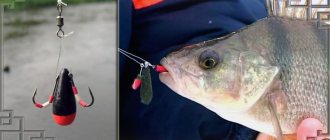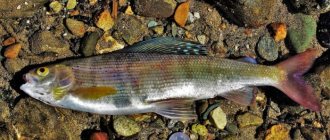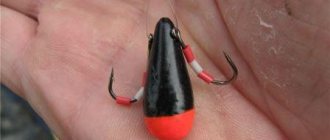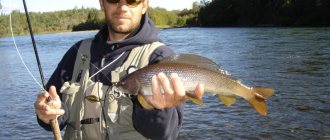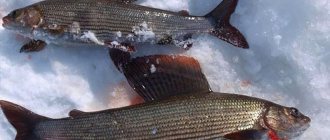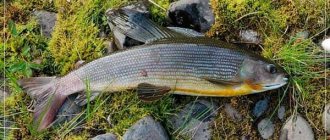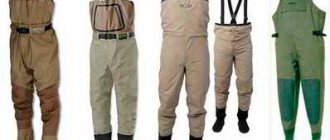Like
IT news
In this article I want to talk about such a wonderful tackle as Balda . For many decades, starting from the middle of the last century and to this day, this tackle has been used by Siberian fishermen to catch grayling, a very beautiful and majestic fish of all Siberian rivers, the pride of our places. It’s even hard to say why this gear attracted me, although, as a folklorist collector, I love fishing with various gear, especially my grandfather’s.
For me, the bulldozer tackle for grayling is attractive because it uses an inertial reel and a float, all this smacks of some kind of antiquity and reliability, or something. The use of a float makes it very different from the more modern tackle called the Tyrolean stick or simply “tyrolean”. Of course, modern fishermen also use multiplier and inertia-free reels for this gear, however, the gear changes a little, especially in terms of wiring, but let’s talk about everything in order, so we prepare the Balda gear ourselves.
Rod for bulldozer
The rods most often used are not very expensive composite rods with a test weight of around 40...80 grams. At the same time, no one forbids using a more expensive, and therefore lighter, carbon fiber rod with the same test. For those who are just beginning to understand all the intricacies of fishing, let me explain that the rod test determines the maximum weight of the casting equipment. With an upper limit of 80 grams, it is worth limiting the weight of the equipment to 70 grams, so that the rod has a small margin of safety. The next important factor is the length of the rod and there are two main directions here. First, you will be fishing from the shore, in this case you should choose a rod no shorter than 3.3 meters, but you should not take a very long one, because It is much more difficult to manipulate a long stick. Secondly, if you are fishing from a boat, then a rod 2.1…2.4 meters long will suffice. You don’t need to cast far from the boat, you can cast right under the side, so a short rod will suffice.
The next important factor that should not be neglected is the structure of the rod. For Balda, they choose rods with a fast action (that is, rigid), this was once recommended to me and this is how it was justified. In order to quickly control the equipment, you need a fairly rigid rod so that the angler’s actions are immediately transmitted to the equipment. This provides clear hooks and, in general, good control of the tackle as a whole. You can, of course, choose a medium action, if it seems that the rod is very stiff and the fish comes off the hook for this reason.
Freight
For cargo tackle, a spinning rod 2.5-3 meters long is used, which is not very flexible (“liquid” rod does not cut through the lip of the fish and leads to frequent derailments). The float with the attitude should be of medium weight: too light one cannot be cast, and a heavy one reacts poorly to a bite.
Thickness of the main line. 0.40-0.50 mm.
However, despite the name, this tackle is a classic bulldozer for catching grayling. The thickness of the leash in calm weather can be 0.20-0.22 mm, in medium waves - 0.25-0.27 mm, and in strong winds and large waves - 0.30 mm.
Graylings take flies tied to thin leashes more often, without fear, and there are much more bites. But you need to take into account that grayling on Baikal can be found very large, up to 1.5-2 kg or more.
It is almost impossible to keep such giants on a weak leash, especially when charging. The depth of the mood is set depending on the time of year.
In spring and autumn, when there are no flying insects, the fly should be closer to the bottom. In summer, grayling takes bait in almost the entire water column.
When fishing on Lake Baikal, hooks No. 5-7 are used to make cargo and artificial flies, which must be bent “under the humpback fish”.
Even in calm weather, meter-long waves sometimes crash onto the shores. an echo of the work of the winds on the other side of the lake.
Fishermen call such swells a rollover. When rolling in, the waves are long and gentle, reaching a height of up to three meters.
They wash away a lot of food for grayling from under the stones. This is where the most productive and interesting fishing happens.
The stronger the waves and surf, the closer the fish comes to the shore.
Grayling takes very well in the waves. Standing motionless on the water surface, but at the same time making vertical movements, the float raises and lowers the bait on a leash.
These movements deceive the grayling, and it bites greedily and confidently. When the fish sways on the wave, when bitten, it disappears under the water much faster than in complete silence.
In calm conditions and without “rolling up,” the float sinks very slowly when biting. A particularly rapid disappearance of the float from the surface of the water is typical for “cleavers,” that is, small grayling.
Practice shows that the larger the grayling, the slower the float goes under water.
Coil
As for the inertia-free reel, many modern fishermen are quite accustomed to using it for retrieving. I haven't tried it myself, so I can't recommend anything. I know that after casting the line handle does not close and the line is allowed to freely come off the reel, holding it with your hand. When a bite occurs, the bow closes and the prey begins to fish out. As was already noted at the beginning of the article, the most relish in this gear is the use of an inertial reel, and not some Chinese one made of thin, almost transparent tin, but the good old, grandfatherly reel made in the USSR - “Nevskaya”. Craftsmen remake these reels, replacing the bushings with bearings, thereby eliminating the backlash and giving the reel remarkable torsion of the drum. Therefore, it is the inertial reel that allows you to make long-distance wiring and clearly control it, braking the drum with the thumb of your working hand and controlling the movement of the float with the flow.
Unfortunately, I can’t tell you anything about the multiplier reel. I would like to get acquainted with this reel in the future. As I heard from one fisherman: “A cartoon is the maneuverability of an inertia with the conveniences of inertia.” In general, there is something to strive for.
Of course, you need to wind a sufficient amount of fishing line onto the reel. For Balda, monofilament fishing line is used, not braided one, because requires the use of at least two stoppers, and braided line cuts them instantly, so only monofilament. An unwinding of 100...150 meters is quite enough, of course you can do more, but why overpay for the extra meters. Another thing is an inertia-free reel, which requires winding the fishing line right under the side of the spool, but in the case of this reel, the diameter and quantity of the fishing line will be indicated on the spool. As for the diameter of the fishing line, there is no need to be zealous and, in my opinion, a diameter of 0.35...0.4 mm is quite enough; thicker fishing lines are no longer needed.
Recently, more and more young fishermen are willing to master the classic type of tackle, with an inertial reel. Many are trying to find that very legend, the Nevskaya reel, which is in principle possible. I myself assembled my gear according to my grandfather’s instructions, with a “Nevskaya” reel. I learned how to make side casts, how to make normal “beards” from fishing line (you can’t do without this), and how to untangle them.
How to assemble the “Gossip” tackle correctly?
The easiest way, of course, is to buy ready-made gossip in a store. But for those who like to make things with their own hands, the process of making gossip will not take much time.
In the same way as described above, it is necessary to cut two floats from solid foam. The first should be large, about the size of an apple, the second - the size of a medium chicken egg.
Both are surrounded with lead balls and plastic tubes are passed inside. They are needed so that the fishing line does not cling to the foam.
Float for the bulldozer
The next component of the fishing tackle for grayling is a float. The float here, as in all float gear, serves as a bite alarm, but unlike a float rod, it also has another task. If we consider the whole Balda setup, then at the end of the setup a sinker or a Tyrolean stick is installed (more on weights a little later), so the second task of the float includes the process of dragging the load behind it. Thus, the float, carried away by the current, pulls with it the entire mood and the sinker accordingly.
The fisherman must approach the choice of a float no less responsibly than the collection of all the equipment as a whole. Much depends on the quality of the floats used. Most use large floats with a carrying capacity of 30...40 grams, clearly visible from a decent distance. There are options for floats with and without an antenna, elongated, ovoid, expanding downwards, in the form of buoys and many others. We can talk endlessly about floats; this is a whole separate topic in this gear. The most advanced fishermen, seasoned old-timers in fishing, make their own floats, which actually do not have the disadvantages of store-bought floats.
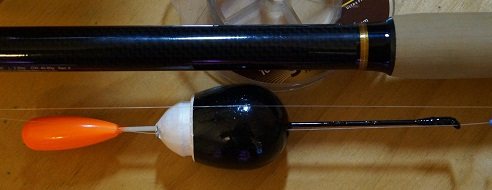
Float for the bulldozer
The picture shows the float that I use. However, there are other floats and the choice often depends on the angler. I prefer to use floats with an antenna; for me they are more noticeable from a distance, and when biting, the antenna provides a more visual signal, because in normal condition, it sticks out well above the water, but when bitten, it disappears under the water or falls on its side.
What time and where to fish
Grayling fishing begins from the time when a huge number of all kinds of insects fly out.
Fish impatiently wait for the occasional fall of flies, beetles and other winged creatures in order to safely eat them. They also do not disdain larvae floating from the bottom. If the weather is clear, then grayling will bite only in the evening or early morning. On cloudy days, fish are active all the time. First, the fisherman needs to find out where the small school of grayling is concentrated. They usually like to stand under swarms of flying insects - there is a high probability of falling into the water. Then you need to throw the bulldozer and you need to do this as carefully as possible.
A strong impact of the float on the water can scare away the target inhabitants! The fisherman needs to get used to the quiet casting of the bombard.
Grayling can bite both stationary and moving bait. Don't move the rod too fast - it looks unnatural and you won't fool the fish. The bombard should not give itself away either: the more it resembles something natural (a piece of bark, a stick), the better.
There are three ways to throw a bulldozer with a fly:
- against the flow of the river. Important nuance! The fisherman needs to reel the line towards himself so that the float moves a little faster than the river;
- with the flow. The fisherman casts the bait down the river, and then slowly winds the reel towards himself;
- across. There is also an important detail here: the fishing line must always be taut. The fly will look natural, attracting the attention of graylings.
You cannot cast without braking the boom just above the surface of the reservoir. If the fisherman does everything correctly, the float will not slap the water, and the likelihood of the line and flies intersecting will be reduced to zero.
The choice of the rod itself for fishing for grayling depends on the intended place and method of fishing. For fishing a reservoir with small spoons and wobblers, a spinning rod with a dough of up to 12 grams is suitable. It should have a fast action and a convenient length from 170 to 250 cm. Tackle for grayling should have an additional margin of safety if you plan to catch this fish on a fast river.
The reel must be in harmony with the spinning rod used. The ideal option is reels with a size of 2500. Be sure to set the drag correctly before you start fishing.
Spinners rarely use regular fishing line to cast spinners and wobblers. Most often they use braided cord.
Grayling can distinguish colors very well, and bright braided fishnets can alert it. It is better if it matches the color of the soil, that is, it will be gray or slightly greenish.
For fishing on mountain rivers, it is enough to have a braided cord with a diameter of 0.10 mm. Its breaking load is enough to pull a small grayling ashore.
To catch this representative of grayling in lakes and deep rivers, for example on the Yenisei, it is worth putting a larger diameter line on the reel, since lake grayling is much larger in size. In addition, it has to be lifted to the surface from a decent depth.
The braid must have a breaking load of at least 5 kg.
Catching grayling in October is a pleasure, since during this period it looks for wintering holes and accumulates in large flocks in one place, but there are also disadvantages, it is during this period that the fish are in a sedentary state and hardly feed, so you can catch it with any bait It will be very difficult, but if you try and choose good tackle, then a successful catch is guaranteed.
It is good to catch grayling on the balda in October; it is during this period that this fish is caught in large quantities and is distinguished by its taste; you can catch both small and quite large specimens.
What is a bulldozer for grayling fishing in October?
The balda for catching perch in October has some differences from the balda for other types of fish, namely, it is presented in the form of a float and a certain piece of fishing line on which there are leashes with hooks; most often the balda is found on spinning rods.
The boom itself is a float that is submerged, most often it is made of wood, but dense and pressed foam plastic can also be used, a sinker is attached to the float below, the weight of which reaches fifty or one hundred grams, in the center of this float there is a gap for passing the fishing line , at the top or bottom, is chosen at the discretion of the owner, leashes of fishing line with hooks are attached.
As for the appearance, it can be very diverse, everything is done at the discretion of the fisherman, the float can be painted in different colors, the leashes of the fishing line can also be attached anywhere, the main thing is that the maneuvers performed bring a good catch of grayling on the bulldozer in October.
How to catch grayling on balda in October?
In general, the process of catching grayling on a bulldozer in October is not difficult, and for an experienced fisherman it is even more so; the main thing is to know the sequence and the correct nuances; first you need to find and determine the bottom.
Since the bulldozer is a bottom tackle and the bottom is a necessary element for fishing. The fishing line that holds it must be in tension and tension, so that the fisherman can feel the slightest fluctuations and bursts of activity of the perch and its bite.
Now you need to swing the rod up, as this is done with a vertical spoon, after that you need to throw the rod down without pausing according to the previous point and stop only at the starting point.
And after the bait has been cast, you need to take a pause, which is different for everyone, everything should depend on the bottom, because it is at the moment of the pause, when the bottom becomes cloudy, that the bite itself occurs. If you perform all these points correctly and consistently, then a successful and large catch is guaranteed.
rybalka7.ru
Sinker
The sinker is an important component of the tackle for grayling; it has an important mission, and it is as follows. After casting the tackle just above the intended fishing point, the sinker sinks to the bottom and begins to drag along the bottom, carried away by the float, repeating its relief. Clinging to the unevenness of the bottom, mainly stones (the tackle does not work on a sandy or clayey, silty bottom), the sinker imparts oscillatory movements to the flies, which in turn repeat these oscillatory movements, emitting the ascent of bottom organisms, provoking a bite from grayling. Grayling is a natural hunter and will definitely attack them, sometimes just out of curiosity to try.
Various lead weights of oblong shape are often used as weights for the bulldozer. This reduces the chance of the load getting stuck between the stones. For example, a ball load can very easily get stuck between two stones or in a crevice; an elongated load has a chance to slip through this area. Tyrolean sticks are often used as weights for Balda. It is believed that the Tyrolean stick does not have the disadvantages of conventional sinkers and practically does not get stuck. Indeed, thanks to the plastic tube, jams are kept to a minimum, although they do occur.
Tyrolean stick
In our conditions, the Tyrolean stick not only took root, but even received local names, such as “ballerina” and “jumper”.
What is this type of spinning equipment? The “stick” itself is a type of vertical sinker, usually up to 20 cm long, and the weight of this type of sinker can range from 12 to 60 grams. The sinker has the shape of a pencil and is a hollow tube with a weight located in its lower part. A leash with bait is tied to the top of the tube.
The stick serves as a limiter that prevents the bait from sinking to the very bottom. As bait you can use a fly, jig, floating wobblers, jig baits or spinners. This tackle works well on rivers with a rocky bottom and fast, strong currents.
If you adapt a Tyrolean stick for fishing for grayling, then it is better to paint the sinker itself in a dark, natural color, although some anglers claim that if you “decorate” the stick with New Year’s “rain,” this will attract the attention of grayling to a greater extent.
As you know, grayling prefers to stay in a section of the river where, after a rocky riffle, the deep section of the river quickly gives way to a shallow section.
Most anglers operate in this area as follows.
On a suitable section of the river, the angler casts the bait to the opposite bank. After the tip of the spinning rod has returned, the wiring begins.
Mood
The setup for balda fishing tackle is the simplest, the simpler the better. Some people use metal leashes in a spirit, but this is unnecessary and once again alarms the shy fish. The simplest and most reliable way is to attach the fly to a leash made of fishing line (lead length about 5 cm) between two knots. The knots are knitted at a distance of about 1 cm from each other. Actually, I knit the setup like this (from below, from the sinker, up): 1. a small swivel for attaching the sinker; 2. after 25 cm comes the first knot, after another 1 cm the second knot is for the lower fly; 3. retreat another 25 cm and repeat the operation with the knots - this is for the upper front sight; 4. step back another 25 cm and knit a loop, a figure eight knot - this is for attaching the setup to the main fishing line. Knots for limiting flies are also knitted in figure eights; this knot is safer for the fishing line than the usual one, familiar to all of us from childhood. Also, don't forget to wet the line when tightening the knots! In addition, it is better to prepare several settings, well, at least two or three, when fishing there are breaks in the mood, there is no escape from this, so in order not to waste time preparing it, you need a small supply of ready ones. When fishing, you need to fish, not set your mood.
Horse
In the warm season, when there are a lot of different insects, grayling is caught on Baikal using riding gear, using riding (dry) artificial flies. Fishing with riding gear is much easier than with cargo gear, where it is more difficult to select a fly and determine the depth. For Baikal, the riding gear is made larger than for rivers, and cast further.
The length of the main leash, depending on the length of the rod, is 2-2.5 meters, thickness - 0.25 mm; it has 2-3 side outlets for flies (each 25-30 cm long). The length of the wooden float is 10-15 cm with a weight of 80-100 g, and the thickness of the main line is 0.40-0.50 mm. Having thrown the riding gear further away, it is slowly pulled towards you so that the fishing line is taut and the flies are slightly hidden by the water.
The bites on riding flies are always sharp, because the fish mistakes them for a living insect that can fly away at any moment. They operate in a self-clipping manner, since the line is tensioned and the float exerts a certain resistance in the water. No hooking is needed for this type of fishing.
The hook of the riding fly is in the water with the tip down and is pierced into the lower, weaker lip of the grayling or the side of the mouth. This can explain the numerous empty bites. To reduce their number, riding flies are made on double or triple hooks No. 5-6. The absence of a load and the long length of the setup enable the grayling caught on the hook to fully express their character.
The vastness of Lake Baikal also allows you to practice fishing “on a boat” or “on a sled.” How to make a “balda” tackle for grayling with your own hands.
Varieties of bulldozer (classical, Siberian, riding spirit). This is also one of the methods of “horseback” fishing.
A main fishing line 0.60 mm thick is attached to a “sledge” made of wood, and, retreating 6-8 meters from this wooden structure, riding artificial flies (12-14 pieces in total) are tied every meter on leashes 30-40 cm long.
Making fishing tackle for grayling. The thickness of the leads is 0.25-0.30 mm.
The fisherman slowly moves the “sled” along the shore and waits for the grayling to start grabbing flies. The inconvenience of this method is the bulkiness of the gear, which is best used by two people.
Collecting tackle
Now that all the components are ready, you can assemble the balda tackle into a single whole. So, we screw the reel to the rod, thread the line through the guide rings, and reel out about one and a half or two meters of line. Then we put on the upper stopper, this stopper will limit the position of the float on the main line and set the depth of the entire tackle as a whole. As a stopper, you can use store-bought silicone ones (I don’t recommend), knit floss from wool thread, or use a nipple tube (I recommend), I use this option myself. We thread the fishing line into the nipple tube, then again, create a loop that tightly secures such a stopper to the fishing line. Changing the depth is also not difficult, just loosen the loop and pull the stopper where needed. So, the stopper is installed, now we thread the fishing line into the float, put on a small bead and tie a swivel with a carabiner, the knot here can be whatever you like best. We attach the setting to the swivel carabiner and the sinker to the setting. That's actually all the simple triplicity of fishing gear is. We adjust our flies and head to the river.

Collected tackle
Lures
Anglers usually use simple figure-of-eight knots. They recommend that beginners start with one fly and gradually acquire the skills of catching grayling with a bombard. If the river is narrow, then there is no need to tie a few more pieces - it will spoil the whole mood.
In the traditional version, the first fly should always be at the very end of the bait line, and those behind it should be on leads. The second method involves only a leash attachment. The equipment is carried out like this, the main thing is not to confuse it:
- The bait line is folded together with the leash.
- A single figure-eight knot is made from them.
- The end directed towards the bulldozer is connected to the fly.
- The one that heads towards the final bait is bitten off and melted.
The knots are reliable, self-tightening - nothing will come off.
There should be a distance of at least one meter between the first fly and the boom!
Mostly flies are used. Sometimes they hang spoons or silicone fish. Not all flies are suitable as bait, or rather, any of them is not always suitable. It depends on the speed of the current of a particular river. Grayling has excellent eyesight and will not grab a hook that is lightly wrapped in lint at low speed.
Graylings are far from stupid fish; this species is considered one of the most capricious. When fishing in slow currents, you need to use flies that are as similar as possible to real insects.
Fishing on fast rivers is much easier when it comes to choosing bait. Here you can safely put on a “coarser” fly, since the grayling will not have time to see it and will grab it. Siberians make them from cambric and wool.
Superficial
Surface baits include any insects that may appear on the surface of the water surface:
- Locust
, grasshoppers. They are more often found in places with vegetation, from where they get into the water. Catching such bait is not difficult, and every experienced angler, using a grasshopper or locust, catches large individuals. - Flies and gadflies. This bait holds on to the second place of the locust field. You can catch the bait using a bottle and something sweet placed in it.
- Midges and mayflies. They usually fly in clouds over the water, so they are easy to catch with a small net. Fishing with this bait is more active in the morning, when midges have just begun to fly over the water. At lunchtime or in the evening, the bite can suddenly stop, as the grayling is actively saturated with the available bait on the surface of the water.
- Beetles. This bait is also very effective in promoting biting. There are especially many beetles in May. You can find them on trees.
Drowning

These types of bait rarely reach the surface of the water. With their help you can catch fish from deep water. These include worms, larvae and others.
In addition to natural baits and lures, artificial ones are also used:
- Front sights;
- Wobblers;
- Spoons;
- Oscillators.
At the end of spawning, grayling will experience a strong hunger. Since the fish is omnivorous, this is the most catchy stage for anglers. When the water clears, it feasts on various insects, which are a good and affordable bait. These are grasshoppers, flies, and flies.
Biting calendar
- January. This month, grayling is at depth and bites reluctantly.
- February. Everything depends on atmospheric circumstances, so it is impossible to predict the fish bite.
- March. This stage will be transitional. Until the 15th the bite will be poor, and after the 15th excellent winter fishing is expected.
- April. Not very active fish are fished in rivers with a current. A worm is used for attachment. At the end of the month the bite will increase.
- May. It bites well on worms, maggots, and bark beetle larvae. From the 15th you can use artificial flies for fishing.
- June. The bite becomes very active. Fishing is carried out using worms and artificial insects.
- July. This period is the peak of fish activity, as many insects appear for which the fish hunt.
- August. The activity doesn't stop.
- September. The fish go into the holes. It is possible to fish with a worm.
- October. Pecks in pits on various insects.
- November. There is a decrease in activity. Can only be caught in deep holes.
- December. With the arrival of frost, activity is at zero. It is located in the deep zones of the river.
The attention of grayling can be attracted by such types of bait as:
- rotating spoons;
- flies;
- wobblers.
According to experts, trolling is considered the most effective method of catching the fish in question. If the purpose of fishing is to hunt for large specimens, then the bait must be of the appropriate size.
In this case, it is necessary to use large flies or heavy spoons. Small grayling are usually caught using small artificial flies.
This salmon fish rarely reaches large sizes, so specimens weighing from 400 to 500 grams are considered a good trophy.
Read more about spinners for grayling here.
When choosing bait, you need to pay attention not only to the size of the desired trophy, you also need to take into account the type of reservoir. So, when fishing on rivers, it is advisable to equip the spinning rod with small spinners. If fishing is carried out in areas where rivers flow into lakes, it is recommended to give preference to large baits.
First cast
After all the stages have been completed, the nerves have been calmed, and the ready-made tackle is standing and waiting in the wings - it’s time to go to the river. We came to the river, found a promising place, prepared the bait for fishing, now it’s time to cast it. If an inertial reel of the Nevskaya type is installed, then you can perform a side cast. To do this, standing facing the river, the rod is retracted, while the drum is held with the thumb of the working hand, cast back and gradually increasing acceleration. At the end of the acceleration, when the rod reaches the desired casting point, we release the reel, but do not forget to slow it down a little so that you don’t get a “beard,” although everyone has a beard, even fishing gurus on the bulldozer.
After the cast is made, it will be clear whether the depth is set correctly. This is determined by the float. If the float stands vertically in the water, the depth is small and it needs to be increased, that is, move the upper stopper up along the main line. If the float moves through the water with some effort (pulls a load along the bottom) and is inclined downstream, then the depth is set normally. In general, the depth is set based on considerations such that it is at least 15 cm greater in a given place of the river. If there is a hole in the fishing area, then you also need to take it into account so that the bully goes through the hole correctly, and not along the top. Thus, on the river you will be able to set the correct depth for some time and start fishing. Don’t forget to change flies if there is no bite after three or four trips.
Equipment Features
There are two options for rigging a bombard for grayling: traditional and “Siberian”. The first involves attaching leashes after the bulldozer to the end where the load is located. In the second case, the angler first attaches the flies, and only then the float.
There is a debate among fishermen about the optimal option. What kind of equipment is better? Both traditional and methods invented by Siberian fishermen have their disadvantages and advantages. The fisherman himself decides about the effectiveness.
Classic equipment:
- in the absence of skills, snags and overlaps can often occur;
- the bait line can be thinner than the main line, which increases the catchability of the gear;
- It is possible to deepen the bait if necessary.
"Siberian" method:
- easy to use even for a beginner: there can be no overlaps, snags or other troubles;
- the thickness of both lines is the same and is selected in accordance with the weight of the loaded float;
- accuracy decreases, but casting range increases;
- Often it is necessary to use locking units and swivels. This is due to the inability to deepen the bait - in this version, the bulldozer will keep it on the surface.
The length of the equipment tied after the rod is limited by the length of the rod. During casting, the very last fly should not touch the ground to avoid snagging. It is better to use long fishing rods.
- The length of the fishing line between the hook and the float depends on the depth of the fished area. When fishing on the surface, the sinker is moved to the float, but if fishing is carried out in deep places in the reservoir, then the sinker must be lowered to the hook.
- The float should be small and light. A goose feather is used as a float when fishing for grayling. It will not frighten wary fish. Grayling can immediately take the bait, can slowly pull it into the water, or can slowly suck it. Therefore, when fishing for this fish, the float must be sensitive. Floats with bright colors are not used; fish will not suit such tackle.
- The fishing line used is more than 0.15 - 0.2 mm thick.
- Hook. The skin and mouth of the grayling are soft and delicate and therefore can fall off the hook at any moment. For large individuals, you need to use thick wire (0.6 mm) and a large hook (No. 9).
- The bit. The fishing rod for grayling should have a light rod, 3-4 meters long. Small rivers are overgrown with bushes, and therefore a long fishing rod can create significant inconvenience if the fishing line gets caught in them.
- Rod stiffness. The hooked fish gives fierce resistance. A hard, inflexible whip will allow him to break off and escape. Therefore, you need to use flexible rods that can absorb jerks.
- Sinker weighing 15 grams for convenient casting of tackle in the current.
- Open spinning reel.
Small and remote
The mini-balda has many advantages. This is a baitless tackle (no need to bother with catching and storing bait), which allows you to quickly fish the entire thickness of the water - in most cases, the horizon from the bottom to one and a half meters above is fished.
In addition, usually the fish quickly reacts to this bait, and if it doesn’t get hooked, it will at least make a poke; accordingly, the tackle seems ideal for finding fish and quickly finding a school, which is so important on large bodies of water on a short winter day.
The main joke of the little fool is that you never know what will bite you. For example, you are sitting, feeding a roach in its typical place, and a large bream flies in. Or I fed, for example, exactly the bream holes, where last weekend I took a large bream, and then a decent perch came up and responded perfectly to the mini-bait.
Read: Playing with a jig when catching perch
Typically, the body of a mini-boob is a slender “pear”. In an effort to miniaturize and achieve high catchability in difficult fishing conditions, the body of the small rod is made of tungsten. Body length is from 3 to 5 mm, rarely more. The body itself must be symmetrical, which allows for much better control over the operation of such a small bait, especially in cases where it is necessary to give it a high oscillation frequency.
What is the best color for a bully to paint her body? There are a lot of artistic options here, fishermen tried a variety of shades and tones, and during the experiments it turned out that in some particular conditions, on a particular body of water, a certain color might work better. But, according to some experienced baldists, there is no need to overthink anything, because the natural color of tungsten in the vast majority of cases, the length of the mini-bald, is the most versatile and catchy. Black color is also good, which can also be considered universal when catching a wide variety of fish.
Hooks for bulldozers are best used with a ring, and with a straight one, not a bent one. An important point: the hook should not be longer than the body of the bait. Of course, different options were tested, but hooks that were longer than the body of the bait brought worse results.
